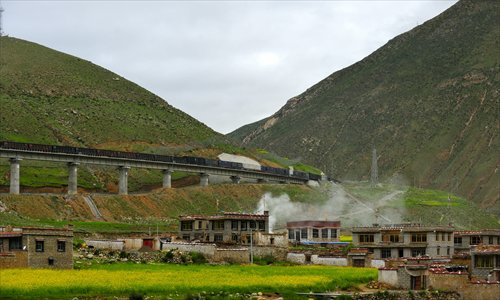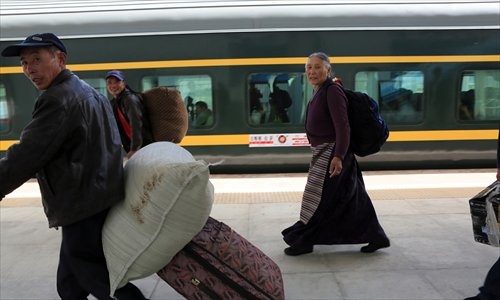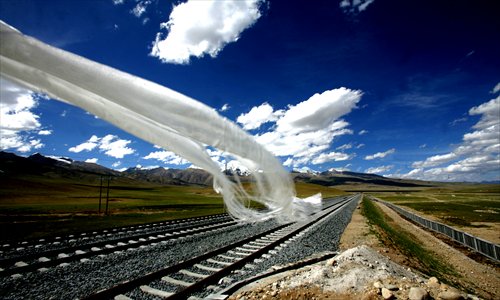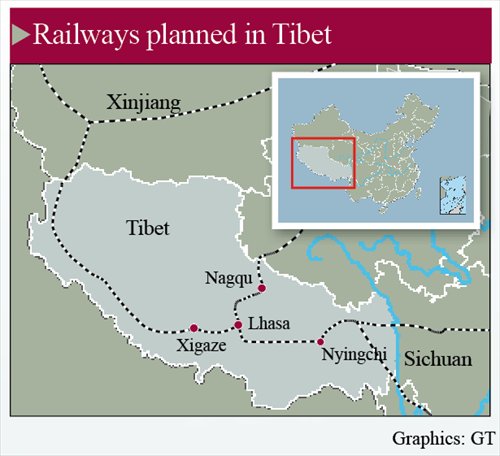On 10th anniversary of world’s highest railway, new lines planned in Tibet
On 10th anniversary of world’s highest railway, new lines planned for plateau
After operating for 10 years, the Qinghai-Tibet railway has brought employment and business opportunities to locals and numerous changes to the region. Right now, four other lines going into Tibet from other neighboring provinces are either being built or planned. The region's expanding railway network will help Tibet develop its economy, as well as help China to improve its ties with neighboring countries.

A train passes by villages in Tibet. Photo: IC
Twenty-one-year-old Phuntsok Dolma thinks her whole family has been affected by the Qinghai-Tibet railway.
The ethnic Tibetan is currently studying in Shanghai. She and her cousin have repeatedly taken trains back and forth from the coast to the Tibet Autonomous Region. But she told the Global Times that her father didn't have this luxury when he left Lhasa for his studies in 1985, because air travel was the only quick way in and out of Tibet. To save money, he only visited home once during his four years of college.
On July 1, 2006, the Qinghai-Tibet Railway, which starts in Xining, Qinghai Province and ends in Lhasa, Tibet began operating. The establishment of the railway line, which is 1,956 kilometers long, finally brought train travel to Tibet.
Friday marked the 10-year anniversary of the railway's opening. Since construction, the lives of many people living along the line have been changed. Right now, more railways and extensions are being built in Tibet, strategically knitting together the region's transportation network.

Tibetan travelers are ready to board the train in Lhasa. Photo: CFP
Changing the region
Before the railway was established, people and products heading to Tibet relied transportation by car or air, which was highly expensive or highly time-consuming.
Meng Fengchao, chairman of the China Railway Construction Corporation Limited (CRCC), the company building the railways going into Tibet, said many say Tibet entered an "era of railway economy" after the line was established and started running smoothly.
"Before the railway, the transportation of products and people depended greatly on cost or weather, but it's different with railway transport," he said. "It's not affected by outside factors and runs in a wide range of areas."
The railway has also brought changes to ordinary people in these areas.
When the Qinghai-Tibet railway started operating, Phuntsok Dolma was studying in middle school. She didn't take it for several years but felt familiar with it, because of all the advertisements. She heard songs about the railway on TV and read numerous news reports.
It was not until she went to high school in Shanghai in 2010, that she started riding the railway line.

A hada (scarf) flaps in the breeze on the railroad. Photo:CFP
"Many students in our class would ride together, we would eat instant noodles when we were hungry, the girls would cuddle together and tell each other stories to pass the night," she said. The railway has made the lives of people like her easier, as well as giving them fond memories of these trips.
In Lhasa, taxi drivers and shop owners told the Global Times reporter that their lives have been changed by the railway as well, whether directly or indirectly.
A woman said the flux of tourists that came on trains has brought her more business than before. She has a small Tibetan food and jewelry shop in the center of Lhasa, near the government headquarters.
According to statistics from the CRCC, in 2000, more than 70 million people in China travelled, but only 150,000 went to Tibet. Tourism made up of only 5 percent of the regional government's revenue for the region.
Without a railway, it was difficult to transport goods into Tibet. Before the railway was built it cost about 400 yuan (US$60) to transport a ton of coal to Qinghai from neighboring provinces, but cost 800 yuan in Lhasa. In 1978, less than 100,000 tons of materials were imported to Tibet and less than 50,000 out of Tibet.
The situation changed with the Qinghai-Tibet railway. In 2015, the railway transported more than 44 million tons of goods in and out of Tibet. In the same year, more than 11 million tourists went into Tibet on the railway, and revenue from tourism increased from 1.8 billion yuan in 2005 to 28 billion yuan in 2015.

The railway also brought coal, oil and gas into Tibet. Back before the railway era, many locals, especially herdsmen, used animal excrement and wood to warm their homes in the winter. Now people are using coal and gas and it's beneficial for the recovery and long-term protection of the region's forests and grasslands, Wang Yang, a member of the CRCC publicity department, said.
Locals have also benefited from the influx of business and job opportunities. In order to help locals break free from poverty, companies employed them in construction. The No.15 group of CRCC employed 7,520 Tibetan locals alone, said Wang. CRCC has also held 192 training classes and trained 6,003 Tibetans.
A local from Lhoka who performed well in the training sessions and learned how to operate machinery became a team leader during the railway construction, Wang said. He now has his own construction company and is leading locals in his town to work on housing projects.
In villages near Lhasa, the changes are rather obvious as well.
"I can't believe the yogurt, sheep and beef jerky that we usually eat can make loads of cash," Jampa, a local herdsman who lives in rural Lhasa told the Tibet Daily. After the railway started operating, he found many tourists came to the area with cameras around their necks.
A few years back, he and his family borrowed 30,000 yuan and set up a few tents to attract tourists. He earned more than 10,000 yuan within half a year. Jampa said this is more than he would make in a year herding sheep.

Strategic planning
The Qinghai-Tibet line was the first one of the five planned lines that has been built. It's also the most feasible out of the five, said Lin Lansheng, the then the vice chairman of the First Survey and Design Institute Group and chief engineer for the Qinghai-Tibet railway in the 1980s and 90s.
Traditionally, there are a few ways to travel by car from other provinces into Tibet from neighboring provinces, such as Yunnan and Sichuan, Lin said.
According to a report about Tibet's railway network released in the Twelfth Five-Year Plan in 2011, there are to be four railways going out of Lhasa, to Xinjiang, Qinghai, Sichuan and Yunnan and one from Changdu, Tibet to Qinghai. The report said these railways will be constructed in three stages and are planned to be totally completed around 2050. When all of these railways are built, Tibet will have 8,895 kilometers of rail.
In 2013, the Sichuan-Tibet railway started construction. This year, a railway from Lhasa to Nyingchi is under construction. This section of railway will be a shared section of three planned railways, Sichuan-Tibet, Yunnan-Tibet and an extension of Qinghai-Tibet to Gansu Province.
The construction of the Sichuan-Tibet line has been difficult, because it climbs to an altitude of 14,000 meters. Because the line climbs through mountainous regions, the construction team has met with earthquakes, landslides, mudslides and even icy glaciers.
The Xinjiang-Tibet railway is expected to be the most difficult. Construction departments have been surveying the area for years, but still cannot find a way to make it possible as of now. The railway is expected to run alongside the No. 318 national highway.
The "One Belt, One Road" initiative has also affected railway construction in Tibet. Tibet is one of the major cities in China's southwest region and the railway net can bring the region closer to neighboring provinces.
A railway from Lhasa to Xigaze was finished in 2014 and within a year, it has brought Xigaze more than 300,000 tourists. At the end of 2014, when Chinese Foreign Minister Wang Yi visited Nepal, leaders from both countries reached an agreement on an extension of the Qinghai-Tibet railway to the borders of Nepal. Experts commented that this railway is expected to bring China closer to neighboring countries and bring economic development.
Newspaper headline: Taking the train to Tibet